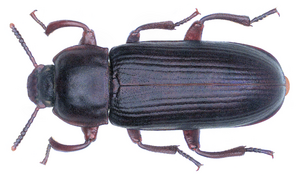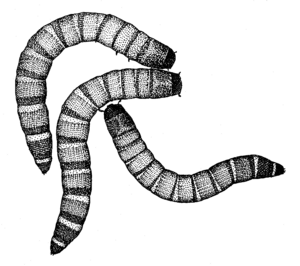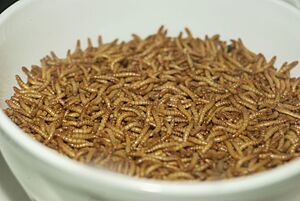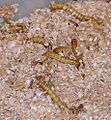Mealworm facts for kids
Quick facts for kids Mealworm |
|
|---|---|
 |
|
| Scientific classification | |
| Genus: |
Tenebrio
|
| Species: |
molitor
|
Mealworms are the young form, called larvae, of the yellow mealworm beetle. This beetle is known scientifically as Tenebrio molitor, and it belongs to a group called darkling beetles.
These beetles like warm places with lots of moisture. Male mealworms release a special scent to attract females for mating.
People use Tenebrio molitor in science studies. Mealworms can be food for animals and even for humans. But they can also be a problem, especially when they get into stored food.
Contents
What is a Mealworm?
Like many insects, the mealworm beetle goes through four main life stages. These stages are: egg, larva (the mealworm), pupa, and adult beetle. This process is called complete metamorphosis.
Mealworm larvae usually grow to be about 2.5 centimeters (1 inch) long or more. Adult beetles are typically between 1.25 to 1.8 centimeters (0.5 to 0.7 inches) long.
Adult yellow mealworm beetles are dark brown or black. You can tell them apart from other beetles by the straight lines on their back. These lines run evenly along their body. Also, they have only four small parts on their back legs, called tarsal segments. Most other beetles of similar size have five of these segments.
Sometimes, people confuse the yellow mealworm beetle with the black mealworm beetle (T. obscurus). But there are differences. The black mealworm beetle's body is more rounded and pointy at the end. The yellow mealworm beetle's body is more like a rectangle and has a blunt end. Also, young yellow mealworms are lighter in color than young black mealworms.
Where Do Mealworms Live?
Mealworms probably first came from the Mediterranean area. But now, you can find them in many parts of the world. This is because humans moved them around through trade and travel.
The oldest signs of mealworms found by archaeologists are from the Bronze Age in Turkey. Later records show them in places like the British Isles and northern Europe. Interestingly, there are no signs of mealworms in ancient Egypt.
The Mealworm Life Cycle
The life of a mealworm starts as an egg. These eggs hatch into larvae (mealworms) in about 4 to 19 days.
From Larva to Adult
During the larval stage, mealworms eat plants and dead insects. As they grow, they shed their skin many times. This shedding is called molting. They can molt between 9 and 20 times. Each stage between molts is called an instar.
After their last molt, they turn into a pupa. A new pupa is whitish at first, then turns brown. After 3 to 30 days, depending on things like temperature, the adult beetle comes out.
In studies, mealworm larvae usually hatch in about 7 to 8 days. The first instar stage lasts 3 to 4 days. After that, the time for each instar can change a lot. This might be due to not enough food or sickness. Most larvae go through 15 to 17 instars before becoming a pupa.
The larvae get longer with each molt, reaching their longest around the 17th instar. After that, their length might decrease a bit. Most larvae turn into pupae between the 15th and 17th instars. Young larvae are white, but they turn brown after their second molt.
How Parents and Temperature Affect Growth
Mealworms born from older beetles tend to have shorter larval stages. They also grow faster when they are younger compared to those from younger parents.
If the temperature is 25°C (77°F), the larval stage is shorter. The number of times they molt also goes down. The adult beetles also live for a shorter time if their parents were older.
Another study found that at 20°, 25°, and 30°C, the age of the parents does not change how long the egg stage lasts. It also doesn't change the weight of the eggs. However, fewer eggs hatch when the parents are older. About 90% of eggs hatch if laid in the first two months. But only about 50% hatch if laid after four months.
How Mealworms Reproduce
Mealworm beetles have many babies. Female beetles dig into soft ground to lay their eggs. A female beetle lives for about 6 to 12 months as an adult. During this time, she can lay around 500 eggs.
Mealworms and Humans
Mealworms are quite useful to humans in several ways.
As Food for Pets and Animals
Mealworms are a common pet food for animals kept as pets. This includes reptiles, fish, birds, and some small mammals. People also put them in bird feeders for wild birds, especially when birds are nesting.
Mealworms are good because they have a lot of protein. They are also used as fishing bait.
You can buy mealworms in large amounts. They usually come in containers with bran or oatmeal for them to eat. Some companies give mealworms a special hormone. This hormone keeps them in the larval stage longer, making them grow bigger, often over 2 centimeters (0.8 inches) long.
As Food for Humans
Yes, mealworms are safe for humans to eat! They are even made into food items like insect burgers that you can buy in stores.
Mealworms are full of protein and fat. They also have a lot of fiber. This makes them a good food source for people. They contain a healthy fat called oleic acid. This fat can help lower bad cholesterol (LDL) and raise good cholesterol (HDL) in your blood.
People in many Asian countries, especially Southeast Asia, have eaten mealworms for a long time. You can often find them in food markets and sold as street food. In recent years, baked or fried mealworms have become popular as a healthy snack.
In May 2017, Switzerland approved mealworms as food. Then, in June 2021, the European Union also allowed dried mealworms as a new food. This happened after the European Food Safety Authority said they were safe to eat.
Mealworm larvae have a lot of good nutrients. For every 100 grams of raw mealworm larvae, there are about 206 calories. They also have between 14 and 25 grams of protein. Mealworms have as much potassium, copper, sodium, selenium, iron, and zinc as beef. They also contain important fats called linoleic acids. They have more vitamins by weight than beef, except for B12.
It's easy to raise mealworms. They can eat fresh oats, wheat bran, or grain. You can give them sliced potato, carrots, or apple for moisture. Because they don't need much space, it's possible to raise many of them in factories.
Mealworms and Waste Disposal
In 2015, scientists found something amazing. 100 mealworms can break down polystyrene (like Styrofoam) into useful organic material. They can do this at a rate of about 34–39 milligrams per day.
During a one-month experiment, mealworms that ate only Styrofoam grew just as well as those that ate regular food. Tiny living things, called microorganisms, in the mealworm's gut are responsible for breaking down the polystyrene. If mealworms are given an antibiotic called gentamicin, they lose their ability to break down plastic. This shows how important their gut microbes are. One specific bacterium, Exiguobacterium species, found in the mealworm's gut, can break down polystyrene in a lab.
Gallery
See also
 In Spanish: Gusano de la harina para niños
In Spanish: Gusano de la harina para niños
- Zond 5, a 1968 space mission where mealworms were among the first living things to travel to and circle the Moon.
- Plastivore








